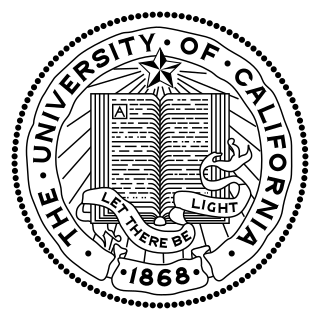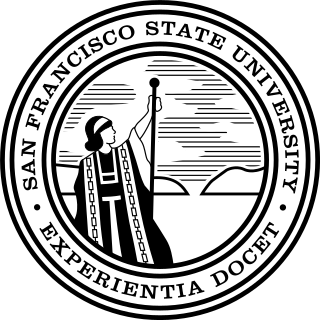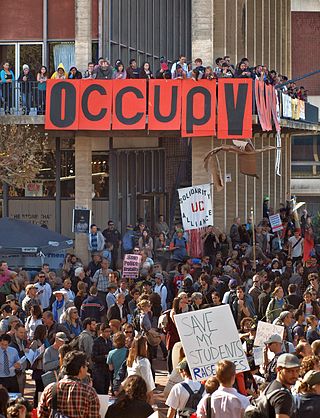Related Research Articles

The University of California (UC) is a public land-grant research university system in the U.S. state of California. Headquartered in Oakland, the system is composed of its ten campuses at Berkeley, Davis, Irvine, Los Angeles, Merced, Riverside, San Diego, San Francisco, Santa Barbara, and Santa Cruz, along with numerous research centers and academic abroad centers. The system is the state's land-grant university, and the flagship campus of the system is UC Berkeley, though UCLA occasionally shares this title. Major publications generally rank most UC campuses as being among the best universities in the world. In 1900, UC was one of the founders of the Association of American Universities and since the 1970s seven of its campuses, in addition to Berkeley, have been admitted to the association. Berkeley, Davis, Irvine, Los Angeles, Santa Barbara, and San Diego are considered Public Ivies, making California the state with the most universities in the nation to hold the title. UC campuses have large numbers of distinguished faculty in almost every academic discipline, with UC faculty and researchers having won 71 Nobel Prizes as of 2021.

The California State University is a public university system in California, and the largest public university system in the United States. It consists of 23 campuses and seven off-campus centers, which together enroll 457,992 students and employ 56,256 faculty and staff members. In California, it is one of the three public higher education systems, along with the University of California and the California Community Colleges systems. The CSU system is officially incorporated as The Trustees of the California State University, and is headquartered in Long Beach, California.

San Francisco State University is a public research university in San Francisco. It was established in 1899 as the San Francisco State Normal School and is part of the California State University system.

Clark Kerr was an American economist and academic administrator. He was the first chancellor of the University of California, Berkeley, and twelfth president of the University of California.

Samuel Ichiye Hayakawa was a Canadian-born American academic and politician of Japanese ancestry. A professor of English, he served as president of San Francisco State University and then as U.S. Senator from California from 1977 to 1983.

Black studies or Africana studies, is an interdisciplinary academic field that primarily focuses on the study of the history, culture, and politics of the peoples of the African diaspora and Africa. The field includes scholars of African-American, Afro-Canadian, Afro-Caribbean, Afro-Latino, Afro-European, Afro-Asian, African Australian, and African literature, history, politics, and religion as well as those from disciplines, such as sociology, anthropology, cultural studies, psychology, education, and many other disciplines within the humanities and social sciences. The field also uses various types of research methods.
Ethnic studies, in the United States, is the interdisciplinary study of difference—chiefly race, ethnicity, and nation, but also sexuality, gender, and other such markings—and power, as expressed by the state, by civil society, and by individuals.

Thurgood Marshall College (Marshall) is one of the eight undergraduate colleges at the University of California, San Diego. The college, named after Thurgood Marshall, the first African-American Supreme Court Justice and lawyer for the landmark 1954 Supreme Court case Brown v. Board of Education, emphasizes "scholarship, social responsibility and the belief that a liberal arts education must include an understanding of [one's] role in society." Marshall College's general education requirements emphasize the culture of community involvement and multiculturalism; accordingly Marshall houses the minors in Public Service and Film Studies for the campus. Significant academic programs and departments have come out of the college over many decades: Communication, Ethnic Studies, Third World Studies, African American Studies, Urban Studies & Planning, and Education Studies.
The history of the University of California, Riverside, or UCR, started in 1907 when UCR was the University's Citrus Experiment Station. By the 1950s, the University had established a teaching-focused liberal arts curriculum at the site, in the spirit of a small liberal arts college, but California's rapidly growing population made it necessary for the Riverside campus to become a full-fledged general campus of the UC system, and it was so designated in 1959.

Nathan Hare is an American sociologist, activist, academic, and psychologist. In 1968 he was the first person hired to coordinate a Black studies program in the United States. He established the program at San Francisco State. A graduate of Langston University and the University of Chicago, he had become involved in the Black Power movement while teaching at Howard University.
The University of California, Los Angeles (UCLA) traces back to the 19th century when the institution operated as a teachers' college. It grew in size and scope for nearly four decades on two Los Angeles campuses before California governor William D. Stephens signed a bill into law in 1919 to establish the Southern Branch of the University of California. As the university broke ground for its new Westwood campus in 1927 and dissatisfaction grew for the "Southern Branch" name, the UC Regents formally adopted the "University of California at Los Angeles" name and "U.C.L.A." abbreviation that year. The "at" was removed in 1958 and "UCLA" without periods became the preferred stylization under Chancellor Franklin D. Murphy in the 1960s. In the first century after its founding, UCLA established itself as a leading research university with global impact across arts and culture, education, health care, technology and more.
The history of the University of California, Berkeley, begins on October 13, 1849, with the adoption of the Constitution of California, which provided for the creation of a public university. On Charter Day, March 23, 1868, the signing of the Organic Act established the University of California, with the new institution inheriting the land and facilities of the private College of California and the federal funding eligibility of a public agricultural, mining, and mechanical arts college.

Occupy Cal included a series of demonstrations that began on November 9, 2011, on the University of California, Berkeley campus in Berkeley, California. It was allied with the Occupy Wall Street movement in New York City, San Francisco Bay Area Occupy groups such as Occupy Oakland, Occupy Berkeley, and Occupy San Francisco, and other public California universities. "Cal" in the name "Occupy Cal" is the nickname of the Berkeley campus and generally refers specifically to UC Berkeley.
The Asian American Movement was a sociopolitical movement in which the widespread grassroots effort of Asian Americans affected racial, social and political change in the U.S., reaching its peak in the late 1960s to mid-1970s. During this period Asian Americans promoted anti-war and anti-imperialist activism, directly opposing what was viewed as an unjust Vietnam war. The American Asian Movement (AAM) differs from previous Asian American activism due to its emphasis on Pan-Asianism and its solidarity with U.S. and international Third World movements such as the Third World Liberation Front.
The Third World Liberation Front (TWLF) rose in 1968 as a coalition of ethnic student groups on college campuses in California in response to the Eurocentric education and lack of diversity at San Francisco State College and University of California, Berkeley. The TWLF was instrumental in creating and establishing Ethnic Studies and other identity studies as majors in their respective schools and universities across the United States.
The Asian American Political Alliance (AAPA) was a political organization started at University of California, Berkeley in 1968 that aimed to unite all Asian Americans under one identity to push for political and social action. The two main chapters were at UC Berkeley, and San Francisco State College, both of which became heavily involved in the larger Asian American movement throughout the 1960s, including at the Third World Liberation Front strikes at SF State and at UC Berkeley. The AAPA identified as an anti-imperialistic, Third World political organization that fought for self-determination and liberation for Asian Americans. They expressed solidarity and support for other people of color throughout the US and throughout the world, particularly in colonized or recently decolonized countries. The AAPA's participation in the Third World Liberation Front strikes at SF State and UC Berkeley resulted in the creation of a School of Ethnic Studies at SF State and an Ethnic Studies department at UC Berkeley. The AAPA was also involved in movements such as the Black Power Movement and the anti-Vietnam War movement. Although both main chapters were short-lived and disbanded in 1969, the AAPA played a large role in the Asian American movement and was influential in encouraging other Asian Americans to get involved in political action.
The Intercollegiate Chinese for Social Action (ICSA) was a student organization formed in 1967 at San Francisco State College. The group organized various community-oriented events and service projects, particularly in the Chinatown community in San Francisco. In 1968, the ICSA joined the Third World Liberation Front (TWLF), a coalition of different student groups advocating for campus reform at SFSU. The ICSA also actively protested traditional Chinese leadership, in particular the Six Companies in San Francisco.
The University of California, Los Angeles Asian American Studies Center (AASC) is an organization that educates students and the general public about the history of Asian American and Pacific Islanders and their experiences. The AASC is one of the leading and groundbreaking organizations to have substantial and credible resources for their research. Located in Campbell Hall, the AASC quickly became a center for resource-gathering and scholarship for the Asian American movement. Asian American student organizations at CSULA, Occidental, USC, and other colleges soon followed. It was a vital hub and training ground for young activists, a place where they could earn a salary while doing community work.
The history of San Francisco State University began in 1857, with a teacher-training program at a high school, which led to the creation of San Francisco State Normal School. It became San Francisco State Teachers College, San Francisco State College, and California State University, San Francisco before becoming San Francisco State University as it's known today.
The College of Ethnic Studies at San Francisco State University was the first Ethnic studies college in the United States.
References
- 1 2 3 4 5 6 7 8 9 10 11 12 Whitson, Helene; Kyles, Wesley. "On Strike! Shut it Down! (Exhibit 1999)". San Francisco State University J. Paul Leonard Library. San Francisco State University. Archived from the original on November 29, 2014. Retrieved 18 November 2014.
- ↑ "Presidents Timeline". San Francisco State University. Retrieved 18 November 2014.
- ↑ Adler, Nancy J. (27 November 1968). "Head of San Francisco State Resigns". New York Times. Retrieved 19 November 2014.
- ↑ Turners, Wallace (14 December 1968). "San Francisco State Begins Holiday Recess Early". New York Times. Retrieved 15 November 2014.
- ↑ Cherian, Alex. "Reagan Interview in Sacramento, Part I". San Francisco Bay Area Television Archive. San Francisco State University Leonard Library. Retrieved 19 November 2014.
- ↑ Davies, Lawrence E. (24 January 1969). "380 Arrested at San Francisco As Students Clash With Police". New York Times. Retrieved 19 November 2014.
- ↑ "Third World Liberation Front: Notice of Demands". The SF State College Strike Collection. San Francisco State University. Retrieved 15 November 2014.
- ↑ "The Third World Liberation Front". The Berkeley Revolution. Retrieved 2019-03-05.
- ↑ Wang, Ling-chi (1997). "Chronology of Ethnic Studies at U.C. Berkeley" (PDF). Newsletter of the Department of Ethnic Studies at U.C. Berkeley 2.2. University of California Berkeley. Archived from the original (PDF) on 2010-06-09.
- ↑ "Richard Aoki Speaks at TWLF Conference - Bay Area Television Archive". diva.sfsu.edu. Retrieved 2019-03-05.
- ↑ "SOLIDARITY!". The Berkeley Revolution. 1969-03-10. Retrieved 2019-03-05.
- ↑ Cordero, Maria; Gonzáles, Genevieve (November–December 1999). "Claiming What is Ours". Against the Current . Retrieved 2020-12-21.